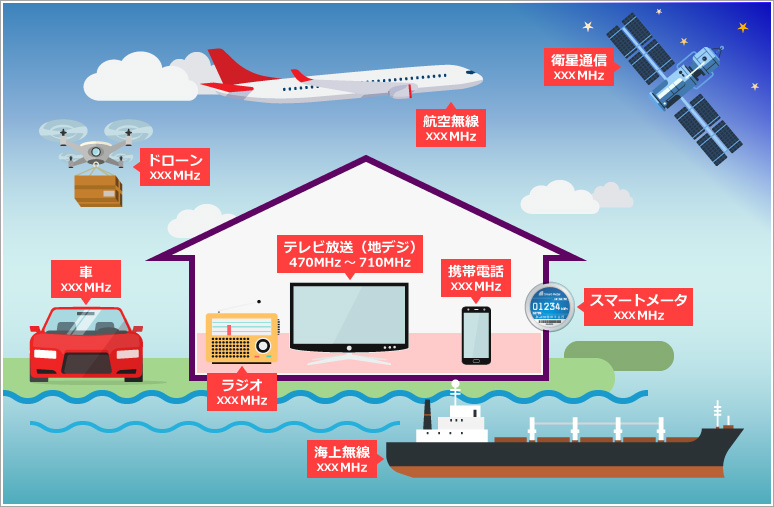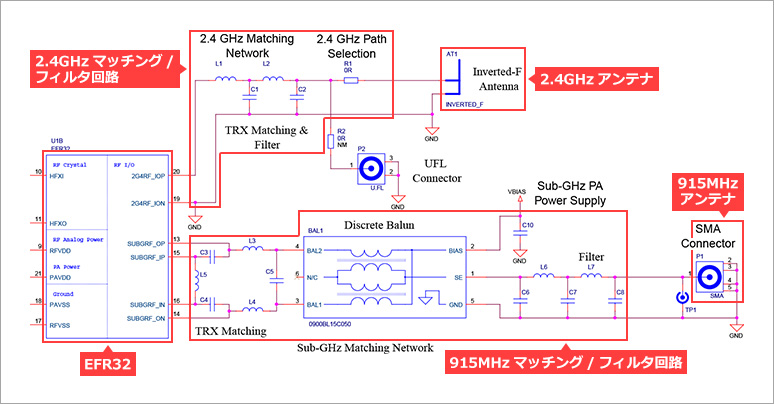Bluetooth®, Wi-Fi, Zigbee, Thread, Z-Wave, Sub-GHz... Silicon Labs has a wide range of very attractive wireless solutions. We would like to introduce you to our attractive product line.
Silicon Labs/Wireless Course series overview
Part 5 is "Sub-GHz Advantages/Disadvantages".
In this article, we will introduce the advantages and disadvantages of using Sub-GHz and solutions that combine Sub-GHz and Bluetooth.
Click here for Sub-GHz basics
Radio waves cannot be used freely
Even if it is 2.4GHz used by Bluetooth or Zigbee, even if it is this sub-giga, radio waves are used.
Radio waves are also used for public services, so if companies and individuals are allowed to use them as they please, it may interfere with the services that should be provided. Therefore, radio waves are used systematically under proper management.
Each country is responsible for its own management, but in Japan, a law called the Radio Law has been established, and the Ministry of Internal Affairs and Communications manages frequencies based on this law.
For example, 470MHz to 710MHz is used for television broadcasting (digital terrestrial broadcasting). xxxMHz is for radio, xxxMHz is for mobile phones, xxxMHz is for aviation radio, xxxMHz is for maritime radio, and xxxMHz is for satellite communication.
Although it was a few years ago, it is still fresh in our minds that the so-called platinum bands of 800MHz and 900MHz were allocated to mobile operators and were frequently featured in the news.
Drones, which are currently in vogue, are assigned 169 MHz as unmanned mobiles.

The frequency usage situation in Japan is published on the website of the Ministry of Internal Affairs and Communications, so it may be a good idea to take a look at it. From 30kHz long wave (LF) to 300GHz millimeter wave (EHF) seems to be managed.
Subgiga in Japan
While the frequency allocation is firmly decided, there are several frequency bands that can be used freely "to some extent" for various purposes.
Typical frequency bands include 426/429MHz band and 920MHz band.
The 920MHz band is a new frequency band that was just opened in 2012. Compared to other bands such as the 426MHz band, it provides higher throughput, so its applications are rapidly expanding.
| frequency band | Main use |
| 426MHz | Car keyless, disaster prevention, security, etc. |
| 920MHz | smart meter etc. |
Sub-giga overseas
I think that all countries have the same idea that radio waves are public, but since each country manages them according to their own circumstances, the frequencies that are open to the public differ from country to country.
The 915MHz band (902-928MHz) is available in the US, and 868MHz and 169MHz are available in Europe.
| Country / Region | Typical frequency band |
| usa | 915MHz, 315MHz |
| Europe | 868MHz, 169MHz, 434MHz |
| China | 470MHz |
What are the benefits of Subgiga?
Sub-GHz is often compared to 2.4GHz, but it has both advantages and disadvantages. A thorough understanding of these issues will make it possible to select the optimal wireless system.
Resistant to obstacles
Compared to 2.4GHz, sub-giga has lower straightness (property of trying to move forward straight), and even if there is an obstacle, it has the property of going around and reaching a long distance.
Therefore, when used in an environment with poor visibility, subgiga has a point.

strong outdoors
2.4GHz is easily absorbed by water, so if it rains, the communication range will be shortened.
Sub-Giga waves, which are also microwaves, are also absorbed by water, but compared to 2.4 GHz, they are less absorbed by water and are less susceptible to the effects of weather.
From the standpoint of stable operation outdoors, it can be said that Subgiga has a point.

good signal environment
The 2.4 GHz band is a band (ISM band) that has been reserved as a frequency that can be used internationally for industrial, scientific, and medical purposes. Therefore, it is very easy to use, and it is used not only for wireless communication such as Wi-Fi and Bluetooth, but also for applications such as microwave ovens. (Wi-Fi uses the 2.4 GHz band for microwave ovens)
On the other hand, the number of devices using 2.4GHz is very large, so the radio waves are also very congested.
Congestion of radio waves increases the possibility of communication failure, communication distance shortening, and communication speed slowing down.
If the communication fails, it can be done by retrying until it succeeds, so in many cases there is no problem in actual operation.
However, for some applications, such as battery-operated products with limited communication frequency, or systems designed for low error rates, a good radio environment is preferred.
In that respect, Subgiga has an advantage.
What are the disadvantages of Subgiga?
Looking at only the merits, it seems that sub-giga is easier to use than 2.4GHz, but of course sub-giga is inferior in some respects. I would like to introduce a representative one of the disadvantages of using sub-giga.
Available frequencies vary by country
As mentioned above, the frequencies that can be used differ depending on the country or region, but different frequencies also cause differences in antennas and matching/filter/balun circuits.
In addition, wireless must be used within the range of conditions stipulated by the Radio Law, and the control software is designed to meet those conditions. However, since the radio law differs from country to country, the control software also differs.
A function to check if the frequency channel you want to use for transmission is available (carrier sense, Listen Before Talk), a time limit for which a frequency channel can be occupied (transmission time limit), operation using multiple channels (frequency hopping, simultaneous The main difference is the number of channels used as a unit).
In other words, when considering shipping equipment to multiple countries, it is difficult to standardize hardware and software designs.
If custom development is carried out for each destination, various costs will be high, and it will be difficult to use sub-giga for equipment that will be carried across countries.
It can be said that 2.4GHz is more suitable than sub-giga if you want to expand your equipment overseas.
Poor connection with display devices
Representative display devices include tablets, smartphones, and notebook PCs, but Subgiga does not have the means to directly communicate with these display devices.
There may be requests to control equipment from a display device at sub-gigabit speeds, or to refer to data collected from equipment on a display device. is needed.
It can be said that Bluetooth and WiFi are more suitable for these applications because they can utilize existing display devices.
Think about how to eliminate the disadvantages
Subgiga as a wireless system looks very attractive.
Characteristics such as wraparound and communication distance are a big advantage over 2.4GHz, and I think there are many applications where it can maintain its superiority even compared to major wireless standards such as Bluetooth and WiFi.
On the other hand, the low compatibility with display devices can be a hindrance when considering service development using sub-giga. One solution approach is to develop a display device that supports sub-gigabytes, but there is no other way than to use widely spread display devices such as tablets.
If we implement not only Subgiga but also Bluetooth and WiFi on the device side, we should be able to take advantage of the characteristics of Subgiga and solve the problem of connecting to display devices.
However, since the number of radios installed in the device will change from one (sub-gigabyte) to two (sub-gigabyte + Bluetooth, for example), the component cost, board size, and design effort will increase significantly.
Wouldn't it be great if both Subgiga and Bluetooth could be realized in one device?
Silicon Labs has come up with a solution that makes this possible.
The key is "multi-protocol support"
There are various wireless standards, but unfortunately there is no all-purpose wireless standard. Supporting multiple wireless standards and using them according to the situation has traditionally been done at the equipment level. Support for multiple wireless standards (multiprotocols) is being realized at the device level.
The EFR32xGxx has enough CPU specs (Cortex-M4F) and flash memory to enable multi-protocol implementation. We also have a product that connects two antennas so that you can achieve both sub-giga and 2.4GHz with a single device.
Simultaneous communication is not possible because the built-in digital processing unit is shared between sub-giga and 2.4GHz, but by using it while switching, it is possible to implement multiple protocols.

The multi-protocol sample code provided by Silicon Labs provides examples of implementing two protocols: Bluetooth and Proprietary.
Since Bluetooth communicates at regular intervals, it is possible to implement two protocols by allocating the other time for sub-giga communication. The RTOS/radio scheduler automatically manages the switching time to some extent.

By implementing Bluetooth together in this way, the Subgiga can have an interface with the display device, which enhances operational convenience.
Choosing the right radio in the right place
Comparing subgiga and 2.4GHz, subgiga has various strengths, mainly in wireless characteristics.
On the other hand, when considering product development and system operation, 2.4GHz may be more convenient in many cases.
As services continue to diversify, it may be difficult to meet all market demands with just one wireless method. We believe that support for multiple wireless systems (=multi-protocol) will become a trend in the future.
Considering Subgiga as a combination like "Subgiga + Bluetooth", I think the field of utilization will expand. This may lead to the creation of new services.
Next time, I would like to introduce the development flow using Subgiga.
Click here for recommended articles/materials
[Silicon Labs/Wireless Course] Sub-GHz Basics
[Silicon Labs/Wireless Course] Zigbee Basics
[Silicon Labs/Wireless Course] Zigbee Development Flow
[Silicon Labs/Wireless Course] Zigbee Environment Construction
Silicon Labs/Wireless Course series overview

